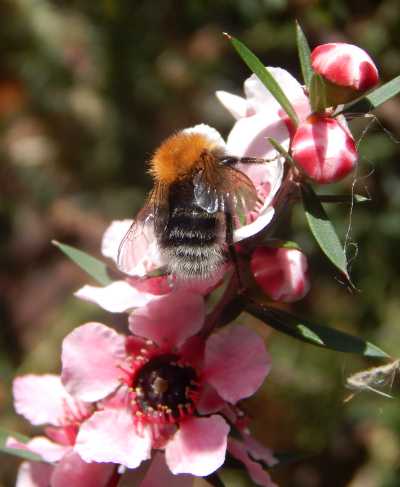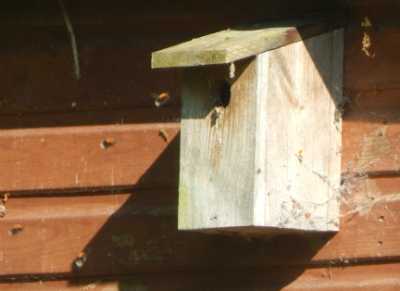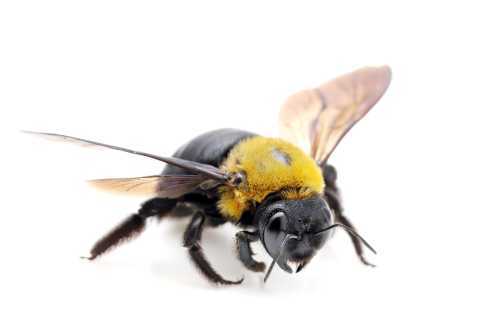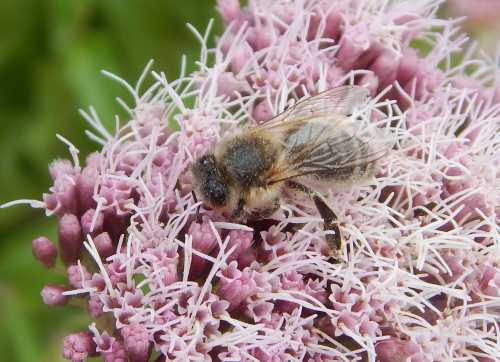Bee Nest In Bird Box Or Bird House
Updated: 1st March 2021
I have had several queries regarding bumble bee nests in bird nest boxes. Very often this will be the nest of the Tree bumble bee, Bombus hypnorum, but other species will also make their nest in bird boxes too, such as Bombus lapidarius.
If you have a bumble bee nest in your bird box, please remember the nest is temporary and will naturally decline and become inactive at the end of the season.
What to do about a bee nest in a bird box
Here is an example of a query I received recently:
"How can I remove a bee nest which is in a bird house? The bird house is on my garden shed, and I am unable to access any tools or my power wash which is inside, because when I attempt to open the door the bees come flying at me ".
 Above: Tree bumble bee, Bombus hypnorum. Easy to identify with its rusty ginger thorax, black abdomen and white tip to the tail.
Above: Tree bumble bee, Bombus hypnorum. Easy to identify with its rusty ginger thorax, black abdomen and white tip to the tail.Although I had no photographs, I suspect this was the Bombus hypnorum, which are quite visibly active around their nests as the colony grows.
Female workers can be quite protective of the nests, deliberately investigating outside disturbance in case of ‘threat’ which they may sense through vibrations – perhaps the moving door of the shed in this case.
How long will the nest last?
As stated above, all bumble bee colonies only last a season (see bumble bee life cycle). If you are seeing quite a few bees, then most likely, the colony will already be mature, and may only last a couple or few more weeks.
Is it worth moving the nest?
Instead of attempting a relocation, you may find it easier to simply take the opportunity to place your main tools etc, temporarily in a different storage place, say in the garage, the greenhouse, the boot of your car, or a neighbour's shed.
It’s possible (though not especially likely) that when feeling threatened, this species can sting. The easiest thing for you to do, is decide what you need the night before, and then at night or late in the evening, when the bees are in their nest, put on protective clothing, and quickly pop something over the entrance of the nest box to stop bees coming out - perhaps a bag or piece of cloth.
Try to be as quiet and efficient as possible so as not to disturb them too much. Then enter the shed and remove the items you need, lock up the shed, and remove the covering from the nest box.
Tree bumble bee "drone clouds" – i.e. males engaged in nest surveillance
It’s common to see males patrolling nest sites (males cannot sting) -
in fact it is often at this point that members of the public first
realise they have a bee nest. The bees are typically seen flying
around the
entrance of the nest, and this is occasionally thought to be a swarm,
although it's actually a group of males engaged in nest surveillance
(sometimes referred to as a ‘drone cloud’), without
actually entering the nest.
 Above: Our neighbour has a Tree bumble bee nest in her blue tit box this year. Above you can see the bees around the nest entrance - in this case, drones (males) which cannot sting. They are waiting to pounce on new queens as they emerge from the nest.
Above: Our neighbour has a Tree bumble bee nest in her blue tit box this year. Above you can see the bees around the nest entrance - in this case, drones (males) which cannot sting. They are waiting to pounce on new queens as they emerge from the nest.They are waiting to pounce on and mate with new queens as they emerge from the nest, and if you are happy to get fairly close, you may even be lucky enough to witness the mating activity, as the bees temporarily appear to fall from the air as if in a fight.
You may at this point see the
bees mating on the ground, or amongst the vegetation.
Should you move a Tree bumble bee nest, if it’s in a bird nest box?
Firstly, please note that although some people find a Bombus hypnorum nest a little intimidating, if left alone, you will probably find them to be little trouble.
As I write, our neighbour has a Tree bumble bee nest in her blue tit box on the side of a garden shed. She has 2 grown children and a dog. The bees are left alone, and no-one is bothered by the bees. Her garden (like ours) is not very large.
We also have a Tree bumble bee nest in our compost bin, and also have a dog. It causes no problems, although we were going to move the compost heap, but that will now be delayed, and we have stopped using the composter for a while. I have been able to potter about, not bothered by the bees. Below is a film of the activity around the nest of our compost heap.
Relocating a nest
It is possible to remove the nest if in a bird box, however, I think most people would find this more stressful than the idea I describe above (removing needed items at night the day before they are required).
It's also a bit tricky, as moving the nest would have to be done at night, when the colony is back in its nest.
However, if you would like to go down this route, first decide on a new location for the nest box - preferably in a similar type of spot, not too far away, and choose a structure that will not be used by humans. Ensure the nest box will be facing the same direction. Have tools handy to fix the nest to its new position. Remove trip hazards.
Wear protective clothing and cover the hole to prevent bees escaping. Remove the bird box from the shed (- consider first - can this be done easily?), and take it straightaway to the new location and fix it firmly in place. The disturbance will alert the bees. Once the nest box is secure, remove the cover from the hole. Be careful!
As stated above, it will probably be easier to leave the bees alone just for a few weeks. If there is anything you need to fetch - say from a shed, follow the advice above.
How to keep bees out of bird houses?
Bees make use of bee houses that have already served as a home to birds. Such sites are already provisioned with nest materials, typically lined with soft moss and dried grass. These materials are also perfect for bumble bee nests. Given this fact, coupled with the shelter provided, it is easy to understand why bees like bird houses!
To discourage bees from nesting in your bird house in future, clear away old bird nests at the end of the season. In any event, this is good hygiene that can help future generations of birds. Old nest materials can also provide shelter for various parasites, enabling them to be transferred from one generation of birds to the next. When it's time for the bird house to be inhabited by birds once more, they will collect fresh materials with which to line the nest box.




